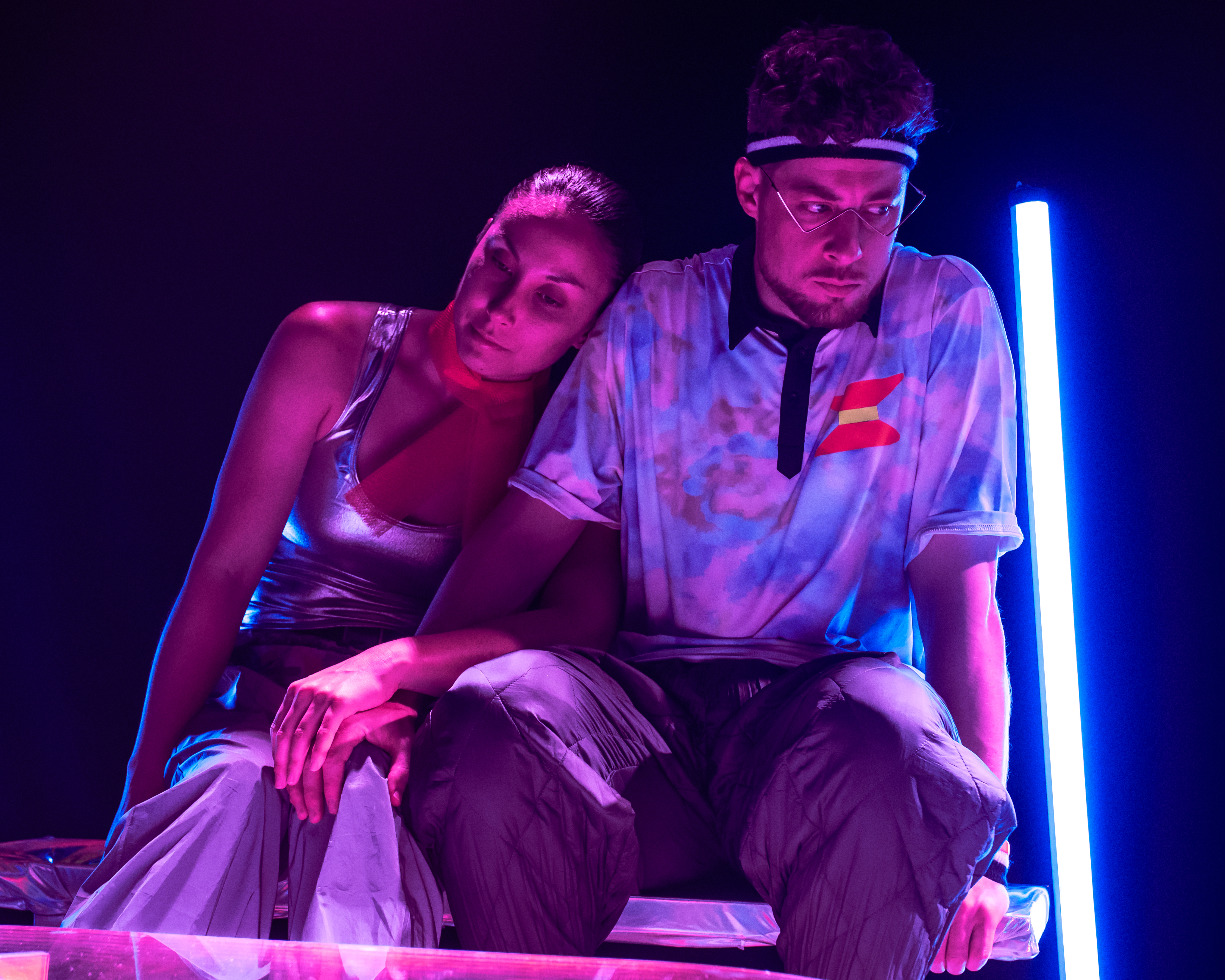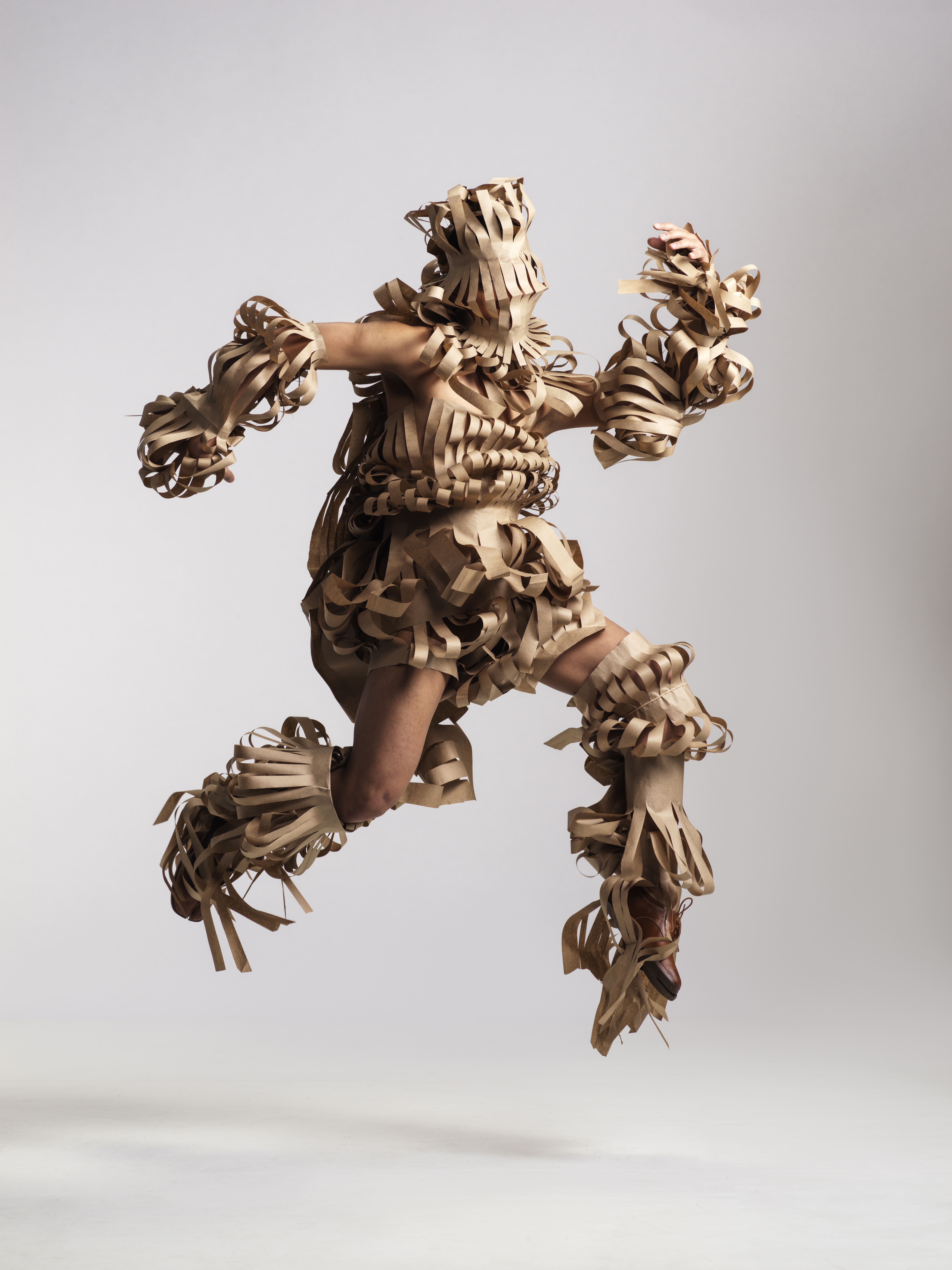“Lossy” by Company 605
“Lossy” by Company 605 allowed the audience to dive into an electric dreamscape, seamlessly blending slow techno beats, rave aesthetics, and video game-inspired choreography. The result left the audience entranced into a pseudo-dystopian underground world.
Entering the theatre amidst fog set the tone with tube lights strategically placed around the stage. The stage was set with monochromatic white tarps piled like clouds in the background with clear iridescent accents, a rug, acrylic furniture, and a bubble chair from the 90s.
Theatre lights dimmed and a strobing floor lamp with a psychedelic rainbow lampshade started to pulse. A subtle low and slow bass drum began to fill the misty air.
Dancers slowly came out on stage, one by one, wearing fluorescent colour block attire in mesh, taffeta, spandex, and sportswear, all of which fit the futuristic underground theme. Each dancer mets in the monochromatic living room, waiting in stillness. Eventually, they all started moving to the beat as if someone was flipping back and forth between frames of a film. This jolting intensified such that the dancers shifted the rug beneath their feet in unison across the stage. This continued and was a consistent theme throughout the piece- quick motions with the rug were used as a vehicle with which to embark into the unknown.

The choreography itself was a masterful synthesis of mechanical precision and fluid expression. Dancers moved in synchronized patterns, mimicking the deliberate yet unpredictable motions of Sims-like avatars. Their rhythmic movements were reminiscent of underground club culture, providing the energy to move in a transcendent hypnosis led by the slow electronic sounds that filled the theatre. What appeared to be random patterns in each dancer’s movements, would all snap into unison as the piece progressed.
Musically, the slow techno track was a key feature in its own right. Its deep, resonant bass-lines and synth layers served as both the heartbeat of the performance and a narrative guide. The tempo, unhurried yet unrelenting, fuelled the dancers to maintain incredible stamina. The dancers’ sustained the steady pace of constant motion through the whole 50 minute piece with brief moments of recovery.

The narrative arc of the piece—yet not explicit—was implied through movement and staging. It appeared to depict a group of people embarking on an adventure, commanded by the music. They would travel throughout the stage in packs, and ultimately reaching a climax all the while slowly re-arranging the set, holding the tube lights as shotguns, manipulating the rug into a cap, or treating the initial strobing light as a cherished specimen to be worshipped at a shrine composed of stacked acrylic furniture.
The last scene depicted the group amongst the white tarps in slow motion, as if they were at sea, going deeper into the abyss trying to spot the destination.
“Lossy” felt like a cool, transcendent fever dream, taking place in a fictional future that had us wondering, “where have they been?” and “where are they going?” The piece felt like a journey through a parallel universe, viscerally familiar, yearning to find an end or a destination, creating experiences that linger long after the music fades.

“Croquis” by FakeKnot
Queer, Canadian-Filipinx artist, Ralph Escamillan aka FakeKnot, takes paper craft to another level, bringing sculpture to life on stage with “Croquis”. “Croquis” explored expression with the crinkling medium as it created mesmerizing tableaus of movement and stillness.
The piece began with a stage covered in brown craft paper. The performer, presumably inside paper sculpture towards the left, seemed to be, about eight feet tall. The towering paper form was reminiscent of paper maquettes that could be found in a fashion house, entirely pleated and wrapping around the artist giving some architectural impact on an otherwise bare stage. The structure was like a dress that imitated something in nature: vague, abstract, yet beautiful.

Once the audience settled in, the lights dim slightly and the sound of a ticking clock commenced. As the artist began to move, so did the structure, building tension in the room with the sound of crinkling paper or a few dry coughs in the audience. The absence of music sharpened the focus on the tactile rustling of paper and combining silence into the artistic medium.
Slowly, the paper layers begin to unravel, wrinkle, or distend the sculpture, and ultimately, collapse inward, without exposing the dancer. It was as if we were watching and listening to a time-lapse of a creature as it transforms, or a flower blooming in reverse. No longer intact, what was once a beautiful, intricate figure was now a mass of crumpled paper. The paper mass inched across the stage, dragging a wooden ladder inside while occasionally exposing the arm or leg of the dancer.

This deliberate act of disassembly felt like a commentary on beauty or perfection—showing the audience that beauty can transform, naturally revealing a more raw and authentic form inside. Such a transformation can be big and messy, but ultimately can lead us somewhere that is more freeing.

The performance was a unique and evocative exploration of materiality, perfection, and movement. It proved that in the absence of conventional elements like music, a performance can still resonate through its primary medium (paper) and engage the senses in unexpected and unforgettable ways.
Learn about Dance in Vancouver over here.
– Ayunda Bagio

